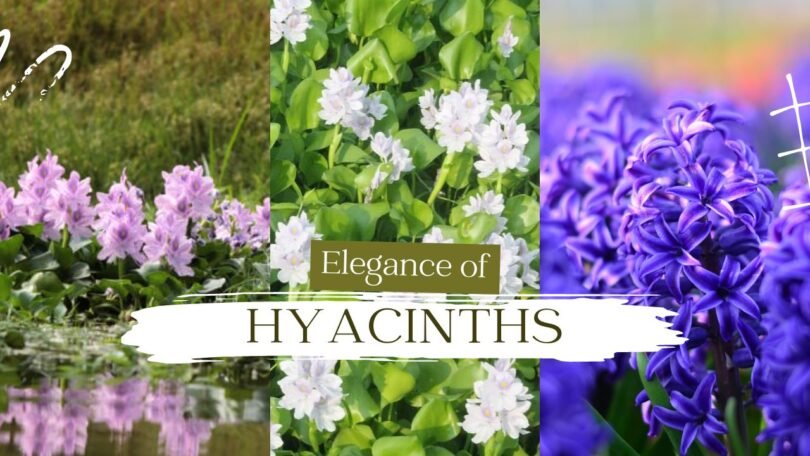Amidst the vibrant and ambrosial springtime shade, the hyacinth emerges as an hallmark of appeal and seductiveness, distinct from its flowery counterparts. As nature reawakens and geographies come a hoot of colours, the hyacinth stands as a witching guard, its ethereal grace witching hearts. Its appeal is a symphony of visual splendour and sweet rhapsody. Petals painted in resplendent tinges, from regal purples to delicate pinks, compose a living masterpiece, bathed in spring’s gentle sun.
Beyond visual poetry, the hyacinth enchants with its ambrosial intoxication, incensing the air with agreeableness. Its substance carried on the breath transforms surroundings into sensitive oases. This scent, transcending time, captivates horticulturists and nature suckers likewise. The forthcoming companion unveils the enigmatic hyacinth world. Origins and strain are traced, unveiling its elaboration through botanical history. Different hyacinth kinds will be extended, each with its own narrative and characteristics, creating a rich mosaic of diversity. The companion becomes a portal to a realm of discovery, inviting us to explore this alluring flower’s secrets and stories.
The Origin and Significance of Hyacinths
Hyacinths (Hyacinthus) have a long and illustrious history, dating back to the tapestry of ancient civilizations. The very name of the flower tells a painful story in Greek mythology. The Hyacinth flower is said to have gotten its name from the tragic story of Hyacinth, a treasured lad who earned favour in the eyes of none other than the dazzling god Apollo. Their link, a symbol of friendship, took a sad turn when fate interfered, causing Hyacinth to transform into a bloom of exquisite petals.
This moving story, tinged with friendship and tragedy, has immortalised the hyacinth as a poignant symbol of regeneration, loveliness, and the fleeting aspect of life. Its petals unfurl as a living testament, capturing the essence of fleeting moments and the undying beauty they bequeath.
The hyacinth’s heritage lives on in the present period, enchanting both people and gardens with its rich meaning and stunning appearance. It serves as a link between old lore and modern appreciation, a reminder of the timeless themes that unite people over the years. The hyacinth weaves a timeless tale as it fills gardens with its vivid variety of hues and enticing perfume, prompting everyone who encounters it to consider the delicate interaction of existence, beauty, and the eternal essence of the human spirit.
Diverse Varieties and Colours
Hyacinths present an alluring palette of colours that spans the diapason from gentle aquarelles to dynamic, vibrant tones, rendering them an incredibly adaptable option for enhancing any theatre or flowery composition. Among their different immolations, one encounters an array of witching
kinds that each retain their own distinct appeal. The classic Dutch hyacinths radiate a dateless fineness, eliciting a sense of nostalgia and ameliorated beauty. In discrepancy, the Roman hyacinths inoculate a touch of ancient mystique, listening back to literal geographies.
A particularly fascinating addition to this flowery shade is the grape hyacinth, also known as Muscari, which imparts a unique and sportful charm all its own. This vibrant multifariousness of hyacinths caters to a multitude of preferences, icing a perfect match for every taste and design sensibility.
Perhaps you’re charmed by the soft beauty of ‘Pink Pearl,’ whose petals emanate a subtle refinement. ‘Blue Jacket,’ on the other hand, is a beacon of bravery, with a vivid and vibrant colour that demands attention. These hyacinth variants are more than just flowers; they are a merger of nature’s craftsmanship and human expression, with a rainbow of hues that reflect the kaleidoscope of human emotions and aesthetics. With such a broad spectrum available, whether your preference is for subtlety or magnificence, there is a hyacinth to harmonise effortlessly with your own style and creative vision, providing a garden or arrangement that resonates profoundly and enchants the senses.
Cultivating Hyacinths: A Step-by-Step Guide
1. Selecting the Best Location: Hyacinths grow in well-drained soil and require a sunny location to thrive. For maximum development, loosen the soil and add compost to the planting area.
2. Planting Hyacinth Bulbs: Hyacinth bulbs should be planted in the autumn, 6-8 weeks before the first frost. Dig holes approximately 6 inches deep and set the bulbs with the pointed end facing up. Allow for growth by spacing them about 6 inches apart.
3. Nurturing Growth: After planting, properly water the bulbs. As winter approaches, a layer of mulch will shield them from frost and temperature swings.
4. Springtime Splendor: As spring arrives, the hyacinths will burst forth with vibrant blooms. Their upright spikes adorned with fragrant florets will create a stunning visual display.
Caring for Hyacinths
1. Hydration: While hyacinths are low-maintenance plants, continuous hydration is required during their growing season. Maintain a consistent moisture level in the soil without becoming saturated.
2. Fertilisation: Applying a balanced fertiliser in early spring, just as growth begins, will supply the nutrients required for good blooms.
3. Deadheading: As the hyacinth blossoms fade, remove the discarded blooms to help the plant to focus its energy on bulb growth.
4. Once Blooming Care: Allow the leaves to fall down naturally once the blooms have faded entirely. This procedure assists the bulb in storing energy for the following flowering season.
5. Dividing and Transplanting: Divide and transplant hyacinth bulbs every few years to minimise overcrowding and maintain vigorous development.
Problems with Hyacinth
Hyacinths, despite their captivating beauty, can sometimes face a range of issues that may affect their growth, health, and overall appearance. Some common problems associated with hyacinths include:
1. Pest Infestations: Aphids, slugs, and snails are a few of the pests that can infest hyacinths. These pests can cause damage to leaves, stems, and flowers, weakening plants and reducing the flowering process.
2. Diseases: Fungal diseases including grey mould (Botrytis) and bacterial soft rot may trigger colouring, wilting, and plant tissue harm in hyacinths.
3. Bulb Rot: Bulb rot can be triggered by poorly-drained soil or overwatering, causing the bulbs to turn mushy, discoloured, and eventually die.
4. Incorrect Planting Depth: Planting hyacinth bulbs too shallow or too deep could’ve had an impact on their growth and flowering. Shallow planting may result in not sufficient root growth, even with deep planting may cause emergence to be stalled or inhibited.
5. Fading blooms: If exposed to direct sunshine or extreme temperatures, hyacinth blooms might fade prematurely. Proper placement in slightly shaded places might help them extend the life of their bright colour.
6. Hyacinth overcrowding: Planting hyacinths too close together might result in poor air circulation and greater susceptibility to illnesses.
7. Fertilisation Problems: Excessive fertilisation or the use of the incorrect type of fertiliser might result in excessive foliage growth at the price of flower output.
8. Environmental Stress: Extreme weather conditions, such as abrupt temperature changes or extended periods of cold, wet weather, can stress hyacinths and impair their development.
9. Wilting: Due to a lack of water, hyacinths wilt and their petals droop prematurely.
10. Inadequate Flowering: Hyacinths may not blossom as planned at times owing to causes such as immature bulbs, insufficient chilling period, or poor nourishment.
To avoid these issues, make sure your hyacinths are properly cared for. Ensure that they are planted in well-draining soil, receive ample sunshine, and are appropriately spaced. Inspect your plants on a regular basis for symptoms of pests or diseases and take appropriate action if necessary. Water them on a regular basis, taking care not to overwater or submerge them. You may enjoy robust, vivid hyacinths in your yard or flower arrangements if you follow basic planting and maintenance requirements.
Conclusion
In the realm of floral elegance, the hyacinth stands as a timeless emblem of grace, beauty, and renewal. From its mythic origins to its enchanting fragrance, these blooms have captured the hearts of gardeners and artists alike. By following the steps outlined in this guide, you too can revel in the joy of cultivating and caring for hyacinths, transforming your garden into a symphony of colour and scent that heralds the arrival of spring’s splendour.



